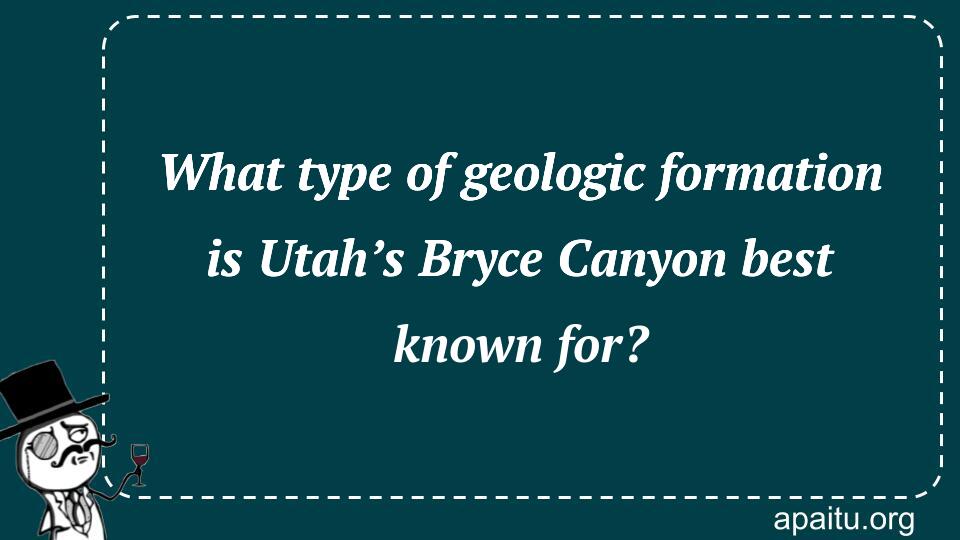Question
Here is the question : WHAT TYPE OF GEOLOGIC FORMATION IS UTAH’S BRYCE CANYON BEST KNOWN FOR?
Option
Here is the option for the question :
- Tor
- Hoodoo
- Outcrop
- Monolith
The Answer:
And, the answer for the the question is :
Explanation:
Bryce Canyon, which can be found in southern Utah, was originally much lower and loaded with larger rocks in its earlier incarnation. Plate tectonic movements, which resulted in the subduction of the Farallon Plate beneath the North American Plate, were ultimately responsible for the elevation of the entire region to its present-day level. Its elevation allowed Bryce Canyon to get the required ice and precipitation, which resulted in the formation of the tall, slender hoodoos that can be seen there today.

Bryce Canyon National Park, located in southwestern Utah, is famous for its unique and stunning geological formations called hoodoos. These hoodoos are tall, thin spires of rock that have been shaped over millions of years by the forces of erosion. They are a natural wonder that draws visitors from all over the world to Bryce Canyon.
Hoodoos are formed by a combination of geological processes, including frost weathering, erosion, and chemical weathering. In Bryce Canyon, the hoodoos are made of sedimentary rock that was deposited over 50 million years ago. The rock layers in the canyon are made up of different types of sediment, including sandstone, limestone, and mudstone. These different types of sediment have different levels of hardness, which can lead to uneven erosion and the formation of hoodoos.
One of the key factors in the formation of hoodoos is frost weathering. In Bryce Canyon, temperatures can fluctuate widely between day and night, and between the seasons. This causes water to freeze and thaw repeatedly, which can cause the rocks to crack and break apart. Over time, this process can create the tall, thin spires that we know as hoodoos.
Erosion is another important factor in the formation of hoodoos. The forces of wind and water can wear away at the rock layers, creating intricate patterns and shapes. As the softer rock erodes away, the harder rock is left standing, creating the distinctive hoodoo formations.
Chemical weathering also plays a role in the formation of hoodoos. Rainwater can dissolve minerals in the rock, which can weaken the rock and make it more susceptible to erosion. This process can create unique and intricate patterns in the rock layers, adding to the beauty of the hoodoos.
The hoodoos in Bryce Canyon are a testament to the power and beauty of nature. They are a reminder of the incredible geological processes that have shaped our planet over millions of years. Visitors to Bryce Canyon can hike among the hoodoos, marveling at their intricate shapes and colors. They can also learn about the geology of the area through interpretive displays and ranger-led programs.
Bryce Canyon is home to a variety of other geological formations, including arches, spires, and natural bridges. The park is also home to a diverse array of plants and animals, making it a popular destination for nature lovers.
Bryce Canyon National Park is best known for its unique and stunning hoodoos. These tall, thin spires of rock are a testament to the power of geological processes like frost weathering, erosion, and chemical weathering. They are a natural wonder that draws visitors from all over the world to Bryce Canyon, where they can hike among the hoodoos and marvel at their beauty. Bryce Canyon is a must-visit destination for anyone interested in the incredible geological history of our planet.